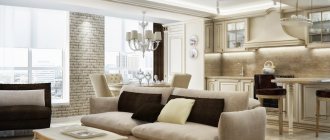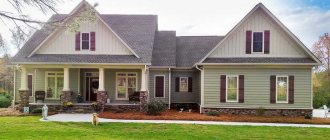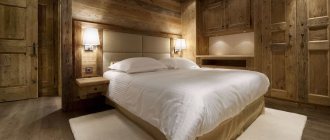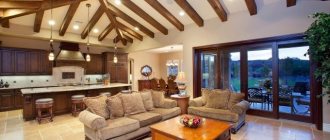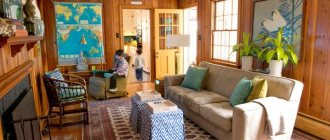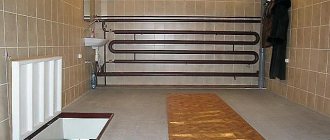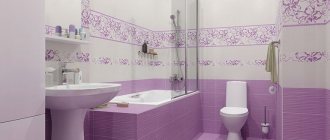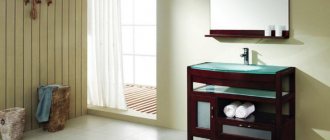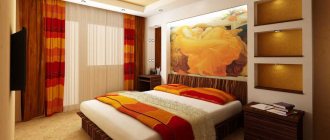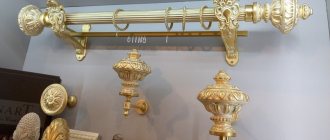Suitable types of lining for the bathroom
There is an opinion that wooden lining is much better than plastic in any of the parameters. Modern technologies do not stand still. PVC sheets are in no way inferior to wooden ones, except that they do not have the natural texture and color of wood. But they allow you to choose a variety of colors for your bathtub design.
When choosing a lining, it is worth considering several factors. To get started, it’s worth answering a few questions:
- Repair price (building materials + installation);
- Quality finish, durability of the structure;
- Color palette and overall design;
- Repair times.
The price of the repair directly determines what type of material you should choose. Cheap repairs involve purchasing plastic lining and installing it on a wooden or metal frame. Expensive repairs (from 20-30 thousand rubles) indicate a wider choice of materials, for example, it could be wooden lining “Euro” of the first or zero grade + coating with an antiseptic, varnish.
The quality of finishing and durability depend on the mounting frame and method of fastening. It is theoretically possible to simply screw the paneling onto self-tapping screws, but this will have a detrimental effect on both the PVC and the wooden wall. High-quality wooden paneling for a bathroom should consist of a durable wooden frame, fastening the sheets using hidden staples, treating all surfaces with antiseptic agents, and separately for the wood - also with anti-moisture varnish.
The color palette and the preparation of the future design are the customer’s choice, however, it also has its own characteristics. Rare types of wood, drawing on plastic or other decorations will significantly increase the overall cost of repair work.
The last point - repair time - indicates the ability to carry out complex work. If you have only 2-3 days to complete it, you should stop at plastic. This option is less demanding on the master and does not require additional manipulations with primer and antiseptics. A longer renovation may allow for the installation of wood panels.
It is also worth considering the feasibility of changing the floor covering, installing new communications, and electricity. All these operations must be completed before finishing work begins.
Subtleties of material selection
When arranging a bathroom using wood material, it is necessary to take into account some nuances. It is necessary to choose certain types of wood. The tree must be resistant to conditions of excessive humidity and have a high degree of resistance to the development of microorganisms. The above requirements are met by such species as elm, ash, and oak. In places where there is intense exposure to moisture, exotic wood species such as bamboo, beech, cedar, teak, larch and others are perfect. However, it is important to remember that the wood must be thoroughly dried before finishing.
In a modern interior, it is important to combine all kinds of wood when decorating a bathroom. Bathroom renovation can be done using solid wood, laminated boards, lining, or veneered boards. Solid wood is mainly used to create decorative elements. All materials must be treated with moisture-protective agents.
For the bathroom use parquet or boards. Before installation, the material is treated using water-repellent and antifungal agents.
After final installation, the wood surface of the floor is additionally coated with paint, wax or varnish. The durability of the flooring depends on how well the wood is selected. Teak flooring in the bathroom is famous for its high fiber density, which is why it is waterproof.
Larch coating is considered less expensive. It is durable and water resistant. Cork flooring is a popular wood flooring option. In damp rooms it is also important to use thermowood. Unlike ordinary wood, thermowood does not deform under the influence of moisture and does not absorb water. The most suitable material for finishing bathroom walls is considered to be a log frame. But due to its high cost, this material is rarely used. Veneered, glued boards, wooden lining, and solid wood are also suitable for finishing walls and ceilings.
How to cover a room with clapboard
Installation of slatted panels is carried out over a lathing made of a wooden block 20-30 mm wide. Provided that soundproofing materials are not laid, the thickness of the block can be 10-20 mm - this is enough to securely fasten and create a ventilation gap on the underside of the wooden surface.
In order not to make a mistake when purchasing material, you need to calculate the amount of lining and timber. They should be delivered two to three days before installation to allow them to adapt to the conditions of the room. The block and lining are treated with antiseptics. “Ordinary” lining is placed vertically, but it can be laid horizontally or diagonally. The lathing is carried out perpendicular to the panels with a step that depends on their thickness - from 50 to 80 cm (the thicker the lining, the larger the step).
The first panel is placed with a tenon to the outer border of the sheathed area. Fastening is carried out through the “body” of the board using thin nails. The attachment points should be closer to the tenon, so that you can then cover them with a plinth, corner or fillet. Metal clamps are used for fixation on the groove side. The second panel is inserted with a tenon into the groove of the first, and secured with clamps. This way the entire surface is covered.
To complete the finishing around the perimeter, use the appropriate profiles:
- the bottom is covered with floor skirting boards;
- at the top - ceiling plinths;
- window and door openings - external corners or platbands;
- corners - fillets or corners;
- joints of sections with different laying directions - flashings.
In addition to wooden lining, there are also slatted panels made of fiberboard and PVC, which are considered “budget” options. Fibreboard lining is used for lining “dry” rooms - it does not tolerate high humidity. Plastic lining for bathrooms and toilets has proven itself well in conditions of high humidity. But due to its low mechanical strength, it is more often used for ceiling cladding.
Destroying stereotypes and dispelling myths
Doubts about the reliability, strength and durability of the finishing material are completely justified. Any choice should be approached responsibly, having first weighed all the positive and negative qualities of the lining.
Main problems:
- Deformation;
- The appearance of mold;
- Moisture.
Having dealt with each problem separately, you can quickly choose the appropriate option for using the lining for finishing.
Installing the mounting frame - step-by-step instructions
For a bathroom, it is not customary to do wall insulation, sound insulation, or other types of finishing work. Because of this, the space between the lining and the wall is not filled with anything, which means that to save useful space it is worth constructing a thin but durable frame.
List of required tools:
- Powerful drill (if possible with a hammer);
- Set of drills for working on stone;
- Screwdriver or screwdriver attachment for a drill;
- Set of dowels + screws;
- Water or laser level;
- Jigsaw or hacksaw for metal.
A good choice of material for the structure would be wide but thin slats (1-2 cm thick). They are easy to install using dowels and screws. Mount the frame to the wall in a horizontal position, maintaining an angle relative to the water level, and not the floor level. Going by eye can ruin a lot of material, because with an error of a few degrees, the unevenness of the structure will be visually visible. For a room 2.5 meters high, you will need 5 slats along the length of the walls (the distance between them is at least 0.5 meters).
After drilling the holes, you need to hammer in the dowels (for greater strength, you can lubricate the dowels in glue or plaster solution). The holes in the planks should be made with a drill 1 size smaller so that the self-tapping screw holds firmly in place.
A frame made of metal profiles can also be used for these works. It is often used for mounting PVC sheets, since wooden ones can be too heavy. Metal profiles are also mounted to the wall using dowels, self-tapping screws, and U-shaped fasteners. Such a frame is a little easier to align in one plane, its adjustment and wear resistance are higher than that of wood. However, the price is much higher and working with it requires a special tool (minimum - a hacksaw, ideally - an angle grinder with a cutting wheel) and the ability to use this tool. The tree is better suited for beginners.
Finishing the bathroom with clapboard can be done only after completion of all the above stages of repair (including the ceiling and floor), preparatory work, etc.
Results
In cases where the bathroom renovation budget is limited, plastic lining is used instead of ceramic tiles. In addition to being cheap, this material is easy to install. Which installation method to choose – frame or glue – depends on the size of the room and personal preferences.
Finishing a bathroom with clapboard: step-by-step instructions with photos and videos
bathroom cladding wall cladding PVC renovation DIY walls
Water supply
In wooden houses, condensation often forms on cold water supply pipelines. Therefore, you should not use steel pipes.
The best option would be plastic pipes. Condensation usually does not form on them or is present in smaller quantities, which eliminates the risk of damage to the wood.
You can minimize the likelihood of the development of putrefactive processes in a tree in the following ways:
- do not install pipes close to walls;
- secure the pipes with rubberized clamps;
- thermally insulate the pipeline with tubular polyurethane foam insulation;
- install a drain valve that drains accumulated water on the floor.
Ventilation arrangement
To protect wood from rot and fungus, it is necessary to equip an effective ventilation system. A constant flow of air should be ensured. To do this, you can create a gap under the door by installing a decorative grille.
Exhaust ventilation plays an extremely important role. It can be taken out into the attic or mounted under a suspended or suspended ceiling, if there is one.
It is recommended to equip ventilation ducts with fire-resistant valves, fans and other equipment. The power of the exhaust fan depends on the area of the room.
Waterproofing
Waterproofing a bathroom in a wooden house is one of the key requirements. To protect walls, floors and ceilings from moisture, materials of the following categories can be used:
- coating They form a durable coating on wood that protects against moisture penetration. This includes mastics and emulsions applied in several layers with painting tools;
- impregnating After impregnation of the wood in several layers, they provide protection from moisture. The composition contains various chemicals, so such materials are not recommended for residential premises;
- stick-on Various waterproofing materials that adhere to overlapping surfaces. A sealant is used to seal the seams.
Alternative materials for finishing the bathroom
To decorate a bathroom in a private house, you can use the following types of materials:
- tile . These products can be used for cladding walls, floors, and ceilings. You can use tiles of different sizes and different shades. It is durable and easy to maintain;
- plastic panels . These products are practical materials that are often used to decorate bathrooms. Simple installation does not require special skills. Easy care and long service life.
When covering walls, floors, and ceilings with clapboards, decking boards, and planks, you must first study the types of wood from which these products are made. preference should be given to varieties with increased resistance to moisture and temperature changes. But still, after installation, it is worth additionally treating the products with special mixtures to protect them from high humidity.
Floor finishing
Before laying the final floor covering, screed and waterproofing must be carried out. The bathroom floor in a wooden house can be covered with the following materials:
- ceramic or porcelain tiles;
- laminate;
- moisture-resistant wood;
- linoleum.
The easiest way to finish the floor is with tiles. It is durable and resistant to moisture. To save money, you can use linoleum.
What elements can be made of wood
Before starting finishing work, you should select the right material. Russian wood species, except oak or beech, cannot withstand prolonged contact with moisture. To ensure that the bathroom does not lose its appearance after renovation, it is worth using exotic types of wood (solid wood or veneer) to decorate it. For example, paduk or iroko, which grow on the African continent, are highly dense and are not afraid of moisture. Such wood in the bathroom interior will last a long time.
The floor in the bathroom is laid using parquet or floorboards. They have an attractive appearance, but to prolong the service life of the material they should be processed.
Before laying, a fungicidal preparation is applied to the wood, and after installing the floor, it is covered with varnish or paint. To preserve the appearance of the material and its texture, use oil or wood wax, which is applied in several layers.
You can decorate the walls in the bathroom with wooden lining, laminated veneer lumber, or solid wood. When installing, small gaps should be provided between wooden elements so that the wall structure is ventilated. If this is not done, mold will begin to develop on the walls of the room and the wood.
Another option is to use veneered, moisture-resistant plywood. It is not afraid of moisture, does not deform, and is easily mounted on drywall or guides placed along the perimeter of the walls.
The walls are decorated not only with wooden panels, but also with cork sheets. To install them, you only need a flat surface and special glue.
The suspended ceiling in the sanitary room can be made of lining or imitation timber. As with walls, the space between the ceiling and the suspended structure must be ventilated.
Natural wood furniture will complement the bathroom interior:
- racks;
- cabinets for small items;
- open shelves;
- sink stand.
The requirements for wood are the same here: it must be resistant to moisture and coated with protective compounds.
Wall decoration
Finishing bathroom walls in a wooden house requires preliminary preparation of surfaces. Under the influence of moisture and temperature fluctuations, the main structure can shrink and dry out.
To prevent deformation, you can install a sheathing, on top of which you can build a false wall. The latter is made from moisture-resistant gypsum board.
Ideas for ready-made designs
Decorating the bathroom with clapboard or blockhouse allows you to create the atmosphere of Provence in the room. To do this, the wood is glazed with transparent paint of white, blue, or turquoise. This coating does not hide the texture of the material. A natural-colored board or terracotta-colored ceramic tiles are suitable for the floor. Ceramic accessories and textiles of the same shades will fit well into the design of the room.
Provence interior is all about attention to detail. You can get ideas for bathroom decor from numerous photos that convey the atmosphere of the French province. In a wooden house with log walls it is easy to decorate a bathroom in a rustic style. It emphasizes the natural beauty of wood and involves the use of massive, even rough structures.
The design of the room, made in high-tech style, also allows the use of wood trim. The ceiling, lined with light-colored clapboard, is well complemented by glass and metal lamps. Light walls covered with clapboard or cork sheets will harmoniously combine with chrome accessories, glass, mirrors, and snow-white plumbing fixtures.
Ceiling
In wooden houses, ceilings in bathrooms are usually suspended or suspended. For tension ones, PVC film is used, and for suspended ones, PVC panels are usually used.
This finish reliably protects the main structure from moisture. Under suspended and suspended ceilings, you can aesthetically hide electrical wiring and ventilation ducts.
When using plasterboard for ceiling installation, use a metal profile coated with zinc or a polymer material that prevents the development of corrosion. GKL is often finished with glass wallpaper; for rooms with high humidity this is one of the most practical finishing options.
Alternative to tiles in the bathroom
Most of all, ceramic tiles correspond to the above characteristics: they are most often used to decorate bathrooms. However, this material is quite expensive, and you can’t put it on the ceiling. In cases where the repair budget is limited, lining, suitable for finishing any surface except the floor, can be a good alternative to tiles. We are talking about products of small width, fastened using a tongue-and-groove method.
There are two types of lining used in the bathroom:
- Plastic. It can be suture or seamless. The latter option involves a more dense joining of the lamellas, which allows you to create an almost monolithic surface. Plastic tolerates moisture well, without requiring additional protection from fungus and mold.
Plastic lining for bathroom
- Wooden. It also has the appearance of lamellas, but is always connected using a suture method. Most often made from pine. As you know, wood reacts poorly to moisture, so before installation it must be treated with antiseptics. Finished surfaces are usually varnished or hidden with wax. In modern bathrooms, this type of lining is not used very often: baths and saunas remain traditional premises for wooden cladding.
Wooden lining for the bathroom
A more suitable option for finishing a bathroom is plastic lining . A common option is when ceramic tiles are laid on the walls and the ceiling is covered with panels. Although, when implementing budget repairs, the walls are also covered with plastic.
The bathroom is lined with clapboard, pros and cons
Lining, as a finishing material, has its advantages and disadvantages. One of its distinctive advantages is its low cost. Compared with standard tiles, plastic panels have an affordable price, accessible to a wide range of consumers.
Installation of the panels is quite simple; even people with minimal basic repair skills can do it.
Lining is a moisture-resistant material that does not absorb moisture, which is its undeniable advantage, allowing it to be used in finishing bathrooms.
In a room finished with plastic, you can install integrated spot lighting, which allows you to create maximum illumination in every corner.
It is worth noting! This material does not require special care, just wiping with a damp cloth is enough.
Unlike ceramic tiles, the structure of PVC finishing material is more heat-containing, which prevents or minimizes the formation of condensation on the surfaces of the room.
This material is popular among consumers due to its light weight, attractive appearance, environmental friendliness, and long service life.
Considering the significant disadvantages of lining, it is worth noting one of them - cluttering up a significant amount of space during installation. To attach it, a metal base is used, which visually makes the room smaller. Because of this, plastic is installed in rooms with a large area.
Features of the tree
A general feature of wood is the invariability of linear dimensions during temperature changes (within the range typical for heated residential premises). Each type of wood has its own resistance to fluctuations in humidity and direct exposure to moisture, but any wood reacts to them in some way. The same lining in the bathroom and in the bedroom will behave differently.
Even products made from tropical and subtropical rocks, which are not subject to rotting at all, can warp with fluctuations in humidity if the drying technology, storage conditions, transportation or operating requirements are violated. Moreover, deformations can be especially severe in wooden products in a cross section relative to the direction of the fibers. But even provided that the wood is well dried and has undergone the necessary treatment with special compounds before covering, there are recommendations on operating conditions.
There are no restrictions for any breed, if you need to clapboard a room with a stable damp regime corresponding to the “dry” or “normal” level (SNiP II-3-79). All living rooms, kitchens, halls, and hallways in apartments and houses in most regions of Russia fall under these requirements. There are some restrictions for the North, the European part of Russia and the Black Sea coast of the Caucasus, but with proper processing and the right choice of protective coating, even ordinary pine lining in the kitchen or living room will not warp there.
The only room in an apartment (house) where the mode can be considered “wet” is the bathroom or combined toilet. Therefore, “moisture-resistant” species should be used here - such as larch, aspen or linden. The last two are even used when decorating a steam room. There are no restrictions on the type of wood if the bathroom is finished with lining made from heat-treated wood. This processing technology provides high moisture resistance even to those species that do not have this in their natural form.
Plastic lining in bathroom design
Plastic panels are widely used in bathroom design. Using PVC material, the walls and ceiling of the room are finished. They are manufactured in the following options:
- glossy;
- matte;
- mirrored
But many experts do not recommend using lining with a mirror surface for the bathroom, although it is easily bendable and can be used as a finishing material for walls and ceilings with uneven surfaces.
Plastic panels are produced:
- white matte without coating;
- white glossy, varnished;
- with an image transferred to thermal film;
- with a printed pattern imitating a certain material (wood, marble, granite).
Important! To create an attractive room design, the lining is carefully selected according to color shades. When purchasing, it is better to take plastic included in one batch.
Bathroom design with clapboard
The quality of bathroom interior design using lining is influenced by the following objective factors:
- compatibility of cladding with plumbing products and other finishing materials;
The lining does not conflict with finishing materials or plumbing design. orientation of narrow long decorative boards on the wall - vertical, horizontal, inclined, patterned (“herringbone”);
Different orientation on the walls. fastening method - self-tapping screws, nails, through, with clamps, on a frame made of bars, galvanized profiles;
Options for fixing the lining to the frame. workability is higher than that of tiles, the lining is easy to drill and cut;
Screen for a bathtub made of clapboard. self-supporting properties are average; light shelves can be mounted on the lining, but not heavy wall cabinets.
A hidden way to attach corner shelves to lining.
It should be noted that the size of the bathroom, especially in secondary housing, is small. At the same time, all existing engineering systems and communications are concentrated inside the room. To route them secretly, boxes are used, which will also have to be covered with eurolining.
Combination of wood with other claddings
Lining belongs to the category of universal cladding, as it can be combined with any known decorative options - from textiles to natural stone. However, there are nuances in relation to finishing a bathroom with this material:
- decorative board is used exclusively for finishing walls and ceilings;
- even if you nail it to the floorboard, it will significantly complicate cleaning the room and reduce the hygiene of the bathroom;
- therefore, tiles, linoleum or porcelain stoneware are usually used as floor coverings, less often PVC tiles or cork;
- lining and tiles are combined in any case, even if the tiles imitate natural stone, parquet, have colors, or the floors are tiled;
- suspended ceilings also harmonize perfectly with wood.
Therefore, in principle, compatibility problems when covering bathroom walls with clapboard do not arise. The photo below shows an example of a project in which the lower part of the walls is decorated with tiles, the top is finished with eurolining.
This was done in order to reduce the labor intensity of designing the connections between the plumbing fixtures and the wall covering.
Orientation of lining on walls
Lining is usually called a thin, narrow, long profiled board with dimensions:
- thickness 12 mm – 50 mm, less often up to 20 mm;
- total width 96 mm – 145 mm, usable width 88 mm – 135 mm, the rest is hidden in a groove;
- length from 2 m to 3 m, less often up to 6 m.
The official types of lining are:
- “eurolining” – tenon length 8 mm, thickness 12.5 mm, width 96 (88) mm, chamfer on the tenon side, rounding along the groove;
- “standard” – width 45 – 120 mm (40 – 115 mm), thickness 13 mm or 16 mm, tenon length 5 mm, chamfer 45° on both sides 2 – 4 mm;
- “calm” – the previous version with a semicircular chamfer;
- “soft-line” is an analogue of calm for eurolining.
In fact, the “imitation timber” and block house finishing options are types of lining. But, most manufacturers position these claddings as independent categories of finishing materials.
Very rarely on domestic construction markets you can find “American” lining with a trapezoidal cross-section, imitating the laying of overlapping boards.
“American” is not used in bathrooms, since these rooms require a smooth, not corrugated surface. For the same reason, eurolining and soft-line, imitation timber and logs (block house) are used very rarely here. “Standard” and “Shtil” cladding are much more convenient to maintain. Depending on the type of wood, the cladding is coated with the following compounds:
- transparent paints and varnishes - they can be used to process boards with an original texture, but are highly hygroscopic;
- colored paints and varnishes – these compounds are best used to paint wood of low decorative value without natural protection from moisture;
Painted paneling in the bathroom.
- wax, oil, combined mixtures - they impregnate coniferous wood.
- in the bathroom there are at least two plumbing fixtures - a bathtub and a sink, the junction of the sides of which with the wall covering will have to be sealed;
- with a vertical or inclined orientation of the cladding, the complexity of sealing the gaps between the bathtub and the wall increases;
When choosing the orientation of the lining on the walls, the following factors are taken into account:
It is very difficult to seal cracks in the joints of the lining when it is oriented vertically
A section of the wall is tiled for a sealed sink junction.
When using linear (long, narrow) panels of any material in confined spaces, a visual effect of enlargement occurs. If the lining is mounted vertically, the height of the ceilings visually increases. When the cladding is oriented horizontally, the illusion of expanding the room appears.
The visual effect of expanding the bathroom due to the horizontal arrangement of dark-colored lining.
The diagonal arrangement of wooden cladding is rarely used in its pure form. But patterns and herringbone inserts are popular.
Decorative lining ornament on certain sections of the walls.
Attention: Traditional tiles can be cut at the junction of the walls or a thin profile can be used. For lining, moldings are usually used - a wooden fillet or plinth, which is much more massive than a plastic corner. In small rooms, such as a bathroom or a combined toilet, this can dramatically reduce the quality of the interior.
How to choose lining for a bathroom?
To extend the life of plastic, when selecting and installing it, you should follow a number of rules:
- you should not buy cheap coating, since usually the manufacturer sets a low price due to the low quality of the product;
- when choosing lining, you need to go through all the panels, paying attention to even the slightest defects, in order to obtain a high-quality material in the end;
- they give preference to boards with numerous cross bars, this will increase the strength to mechanical stress and extend their service life;
- the coating must be sufficiently durable. It is easy to check on both its edges;
- the front side should not have scratches, cracks, chips, dents, or holes;
- The drawing should be clear and uniform. Its contours should not be blurred;
- in rooms where the humidity is quite high, the panels are installed in such a way that there is constant access of air to their underside. This is possible by creating holes near the ceiling and floor;
- For lining, only installation in a vertical position is used, which will not allow liquid and condensate to linger in its grooves.
Protecting wood from moisture
Varnishing is the most common way to protect wood in the bathroom from increased moisture and preserve its original appearance. So:
- Varnish can be used to coat both exotic and local wood species. To do this, you can only use varnishes with water-repellent properties. The film of such water-repellent varnish never leaves the surface and does not crack, and this prolongs the life and preserves the overall appearance of the wood. It is advisable to repeat varnishing of wood after 5-7 years.
- Coating wood with oil is the most effective way to protect against increased moisture, since oil fills even the smallest cracks in the wood. Despite effective protection, oil coating has many disadvantages: after some time, the wood in the bathroom becomes dull, and to prevent this from happening, you need to repeat the oil treatment monthly. Wood treated with oil also looks much darker than natural wood, especially in the photo.
- Toning is also a kind of protection, but more often it is used to imitate the color of valuable rare wood species. To maintain the desired color, the tinting process must be repeated after 2-3 years.
Plastic lining
Plastic lining
The optimal option for finishing rooms of similar functionality. The lining pleases with its assortment variety. The material can be found not only in different colors, but also textures and even with 3D images. Although this is a budget solution, PVC will last much longer than wood. If you make a ceiling in the bathroom from this lining, as in the photo, then it will be possible to organize overhead lighting. Flexible strips are easy to replace if necessary. To do this, you do not need to disassemble the entire structure.
It’s difficult to say for sure which option is better. Each has its own disadvantages and advantages, but if you are going to decorate the room yourself, then still choose polyvinyl chloride. It is much easier to work with plastic, and after that it will not require any special care.
Useful tips
The purchase of lining should be made only in a specialized store or construction market, where the buyer will be provided with a quality certificate upon request. Having a receipt will help you return or exchange the product if necessary.
Also, by following a few tips, the owner will protect himself from some unpleasant moments.
How to treat wood in the bathroom
Natural varnishes are not very suitable for these purposes, since moisture still passes through the micropores, and the wood in the bathroom directly under the varnish begins to turn black and swell. It is also impossible to use water-soluble antiseptics, since their properties are lost with constant contact with moisture. But such substances have been found - these are special water-repellent impregnations with antiseptic properties based on organic varnishes. Manufacturers also produce combined formulations. They are cheaper in cost, but the results are worse than when used alternately.
The fact is that for an antiseptic, the task is to penetrate as deeply as possible into the thickness of the wood and give it the properties of not decomposing from moisture. And the finishing coat of varnish creates a protective film on the surface. Mixing these two substances does not allow them to fully perform their functions. That is why, when using wood in a bathroom for cladding walls and ceilings or for making furniture, it is important to follow the entire procedure for processing wood on literally all surfaces, including edges, fastening elements, and back fastenings.
If we evaluate the stability of the material, then the surface of plastic or ceramic tiles is somewhat more practical than finishing a bathroom with wood, taking into account the constant humidity and temperature changes in the room. If you have decided on a wooden finish, then at the moment there are many different ways to protect the wood material; they will significantly increase its moisture resistance. This will help you end up with a stylish, cozy and eco-friendly bathroom.
How to get rid of condensation?
To prevent condensation from appearing on the panels, a ventilation system must be thought out. Installation of a fan is necessary in the place where the hood is installed. The bathroom door should have a small gap at the bottom for free air circulation.
Is it possible to protect yourself from moisture?
For additional protection of plastic panels, transparent wax or varnish is used to coat them.
Plastic lining is considered one of the best materials for finishing a bathroom. To create wall and ceiling surfaces, no special professional knowledge and experience is required. But the end result is a durable, practical, unpretentious product to use.
Finish options
Finishing methods may vary. Fully finishing an apartment with clapboard is rare, but in the interior of a house it is a popular option.
In a city apartment, lining is used in doses:
- for covering walls in a separate room;
- to highlight a zone in a large room;
- as panels as part of the combined decoration of living rooms or bathrooms.
Kitchen decoration with clapboard is especially popular: full (with the exception of the apron in the area of the sink and stove) or combined - wood in the dining area, tiles in the work area.
The walls of the hallway and hall can also be sheathed either from floor to ceiling, or partially - in the form of panels at the bottom.
Wooden lining in the toilet can be used for complete decorative cladding if the riser pipes are hidden in a separate plumbing box made of moisture-resistant material.
In the living room or bedroom, if the house is not made of wood, lining is used to highlight a certain area. And the texture and color are selected according to the general style - for furniture and interior doors.
The attic is a special case. Regardless of what materials the house is built from and the finishing of the remaining rooms, it can be completely covered with wood.
The lining for the bathroom must be made of hardwood with mandatory impregnation with hydrophobic and antiseptic compounds. And the finishing treatment should be a multi-layer coating of varnish or oil. But heat-treated boards are most resistant to humidity. This finish looks especially harmonious if the washbasin, bathtub or shower cabin is made of wood.

